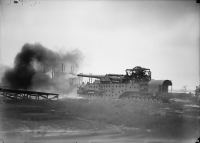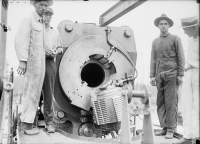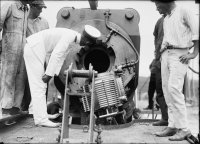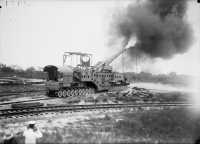Came upon some interesting photos from 1919.
Not sure if this is one of the guns described on Wikipedia:
Baldwin Locomotive Works delivered five 14"/50 caliber railway guns on trains for the United States Navy during April and May 1918. Each 14"/50 gun [SUP][14][/SUP] mounted on a 72-foot (22 m), 535,000-pound (243 t) rail carriage with four 6-wheel bogies was under the command of a United States Navy lieutenant with a standard U.S. Army 2-8-0 locomotive, a 10-ton crane car, two armored ammunition cars carrying 25 shells each, two cars carrying the recoil pit foundation materials, two fuel and workshop cars, three berthing cars, a kitchen car, a commissary car, and a medical dispensary car. A sixth locomotive pulled a headquarters car for Rear Admiral Charles Peshall Plunkett, with a machine-shop car, a spare parts car, a berthing car, a kitchen car, a commissary car, and a medical dispensary car.[SUP][15][/SUP] After delivery by ship, these trains were assembled in St. Nazaire in August[SUP][16][/SUP] and fired a total of 782 shells during 25 days on the Western Front at ranges between 27 and 36 kilometres (30,000 and 39,000 yd).[SUP][17][/SUP] Each 14-inch (36 cm) projectile weighed 1,400 pounds (640 kg) and was fired at 2,800 feet (850 m) per second. The railway carriages could elevate the guns to 43 degrees, but elevations over 15 degrees required excavation of a pit with room for the gun to recoil and structural steel shoring foundations to prevent caving of the pit sides from recoil forces absorbed by the surrounding soil.[SUP][18][/SUP] The trains moved cautiously because axle loading under the gun barrels was 50,330 pounds (22.83 t) while French railways were designed for a maximum of 39,000 pounds (18 t). These axle journals overheated at speeds of more than 10 kilometres (6.2 mi) per hour. After reaching its intended firing site and constructing the recoil pit, each gun could fire about two shells per hour. One of these guns was retained after the war as an ammunition test gun at the Dahlgren Weapons Laboratory until all United States battleships with 14"/50 guns were scrapped shortly after World War II.[SUP][15][/SUP] The gun was then placed on display outside the museum at the Washington Navy Yard.
https://en.wikipedia.org/wiki/Railway_gun
P.S. The admiral in the photo with all the brass is identified as Group. Adm. Earle, 6th from Right
Not sure if this is one of the guns described on Wikipedia:
Baldwin Locomotive Works delivered five 14"/50 caliber railway guns on trains for the United States Navy during April and May 1918. Each 14"/50 gun [SUP][14][/SUP] mounted on a 72-foot (22 m), 535,000-pound (243 t) rail carriage with four 6-wheel bogies was under the command of a United States Navy lieutenant with a standard U.S. Army 2-8-0 locomotive, a 10-ton crane car, two armored ammunition cars carrying 25 shells each, two cars carrying the recoil pit foundation materials, two fuel and workshop cars, three berthing cars, a kitchen car, a commissary car, and a medical dispensary car. A sixth locomotive pulled a headquarters car for Rear Admiral Charles Peshall Plunkett, with a machine-shop car, a spare parts car, a berthing car, a kitchen car, a commissary car, and a medical dispensary car.[SUP][15][/SUP] After delivery by ship, these trains were assembled in St. Nazaire in August[SUP][16][/SUP] and fired a total of 782 shells during 25 days on the Western Front at ranges between 27 and 36 kilometres (30,000 and 39,000 yd).[SUP][17][/SUP] Each 14-inch (36 cm) projectile weighed 1,400 pounds (640 kg) and was fired at 2,800 feet (850 m) per second. The railway carriages could elevate the guns to 43 degrees, but elevations over 15 degrees required excavation of a pit with room for the gun to recoil and structural steel shoring foundations to prevent caving of the pit sides from recoil forces absorbed by the surrounding soil.[SUP][18][/SUP] The trains moved cautiously because axle loading under the gun barrels was 50,330 pounds (22.83 t) while French railways were designed for a maximum of 39,000 pounds (18 t). These axle journals overheated at speeds of more than 10 kilometres (6.2 mi) per hour. After reaching its intended firing site and constructing the recoil pit, each gun could fire about two shells per hour. One of these guns was retained after the war as an ammunition test gun at the Dahlgren Weapons Laboratory until all United States battleships with 14"/50 guns were scrapped shortly after World War II.[SUP][15][/SUP] The gun was then placed on display outside the museum at the Washington Navy Yard.
https://en.wikipedia.org/wiki/Railway_gun
P.S. The admiral in the photo with all the brass is identified as Group. Adm. Earle, 6th from Right






